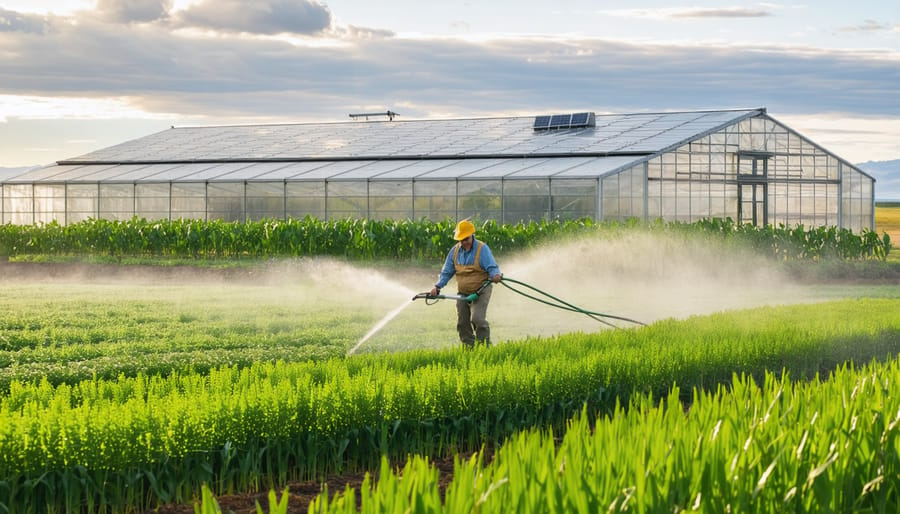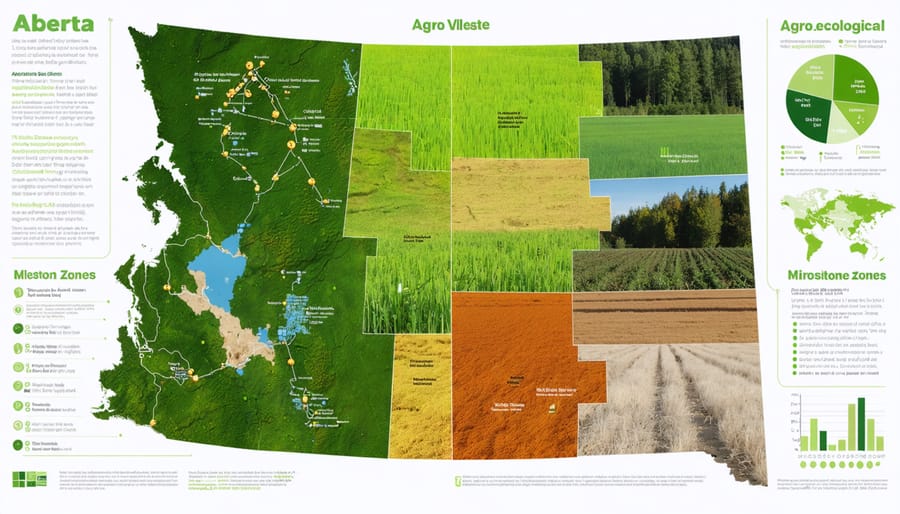Adopt climate-smart practices to build your farm’s resilience against the impacts of climate change. Diversify your crops to spread risk and improve soil health. Implement water-saving irrigation techniques like drip irrigation or cover crops to conserve moisture. Plant windbreaks and shelterbelts to protect against erosion and create microclimates that support crop growth. By taking proactive steps now, you can ensure your farm remains productive and profitable for generations to come, despite the challenges posed by a changing climate.
Understanding Climate Challenges in Alberta Agriculture
The Impact of Climate Change on Crop Yields
Climate change poses significant challenges to crop productivity, with rising temperatures, altered precipitation patterns, and increased frequency of extreme weather events. These factors can lead to reduced crop yields, diminished crop quality, and increased vulnerability to pests and diseases. In Alberta, where agriculture is a vital component of the economy, the impacts of climate change on crop yields are particularly concerning. Studies have shown that without adaptive measures, crop yields in the region could decrease by up to 20% by 2050 due to the effects of climate change.
To maintain and improve crop productivity in the face of these challenges, farmers must adopt climate-resilient farming practices. This involves implementing strategies that enhance the ability of crops to withstand and recover from the stresses associated with climate change. Some of these strategies include diversifying crop rotations, improving soil health through cover cropping and reduced tillage, and optimizing water management through precision irrigation techniques. By proactively adapting to the changing climate, farmers in Alberta can build resilience into their cropping systems, ensuring the long-term sustainability and profitability of their operations.

Water Scarcity and Irrigation Management
Water scarcity is a growing concern for Alberta farmers as climate change affects precipitation patterns and increases the risk of drought. Efficient irrigation management is crucial for maintaining crop yields and conserving water resources. Adopting precision irrigation techniques, such as drip irrigation or variable rate irrigation, can help farmers apply water more accurately and minimize waste. Soil moisture monitoring and weather forecasting tools can also aid in optimizing irrigation schedules.
Investing in water storage infrastructure, like retention ponds or cisterns, can help farmers capture and store water during periods of excess for use during dry spells. Implementing conservation tillage practices and maintaining crop residue on fields can improve soil water retention and reduce evaporation. Additionally, selecting drought-resistant crop varieties and diversifying crop rotations can enhance a farm’s resilience to water scarcity.
By embracing these strategies and staying informed about advancements in irrigation technology, Alberta farmers can proactively manage water resources and adapt to the challenges posed by climate change. Collaboration with local agricultural organizations, such as the Alberta Irrigation Districts Association, can provide valuable support and resources for implementing water-efficient practices on the farm.
Strategies for Building Climate Resilience on the Farm

Diversifying Crop Rotations
Diversifying crop rotations is a powerful strategy for building climate resilience on Alberta farms. By introducing a variety of crops, farmers can improve soil health, reduce pest and disease pressure, and enhance nutrient cycling. Crop diversity also spreads risk, ensuring that if one crop fails due to extreme weather events, others may still thrive. Consider incorporating drought-tolerant crops like sorghum, millet, or chickpeas, which can withstand periods of low rainfall. Alternatively, explore cold-hardy varieties that can extend the growing season and take advantage of changing temperature patterns.
When selecting new crops for your rotation, consult with local agricultural experts and seed suppliers to identify varieties well-suited to your specific region and climate. Conducting on-farm trials can help you evaluate the performance of different crops under your unique conditions. By sharing your experiences with other farmers in your community, you can collectively build knowledge and adapt to the challenges posed by climate change. Embracing crop diversity not only enhances the resilience of individual farms but also strengthens the overall agricultural sector in Alberta, ensuring a stable food supply for generations to come. For more strategies on building resilience, consider exploring game-changing climate solutions for Alberta farmers.
Adopting Conservation Tillage Practices
Conservation tillage practices, such as no-till or reduced tillage, play a crucial role in enhancing soil health and moisture retention, ultimately contributing to more climate-resilient farms in Alberta. By minimizing soil disturbance, these practices help maintain soil structure, increase organic matter content, and promote the growth of beneficial microorganisms. This leads to improved soil fertility, better water infiltration, and reduced erosion. When combined with cover cropping and efficient irrigation practices, conservation tillage can significantly enhance soil moisture retention, allowing crops to better withstand periods of drought or inconsistent rainfall. Adopting these practices not only builds resilience against climate change but also contributes to long-term soil health, leading to more sustainable and productive farms for generations to come. Alberta farmers who embrace conservation tillage as part of a holistic approach to climate-resilient agriculture will be better positioned to adapt to the challenges posed by a changing climate while maintaining the viability of their operations.
Integrating Agroforestry and Shelterbelts
Integrating agroforestry and shelterbelts into your farming practices can significantly enhance climate resilience while providing numerous ecological benefits. By strategically planting trees and shrubs alongside crops, you create a natural barrier that protects your fields from harsh winds, reduces soil erosion, and helps retain moisture. These living windbreaks not only safeguard your crops but also provide habitat for beneficial insects and wildlife, promoting biodiversity on your farm.
Moreover, agroforestry systems act as powerful carbon sinks, actively sequestering carbon from the atmosphere and storing it in the biomass and soil. This process helps mitigate the impacts of climate change while improving soil health and fertility. By incorporating agroforestry practices, such as alley cropping, silvopasture, or riparian buffers, you can diversify your farm’s income streams, enhance crop yields, and contribute to a more sustainable and resilient agricultural landscape in Alberta.

Empowering Alberta Farmers through Knowledge and Community
Access to Resources and Workshops
Alberta farmers have access to a wealth of resources, workshops, and training programs designed to help them implement climate-resilient farming practices. The Alberta Ministry of Agriculture and Forestry offers a variety of online resources, including guides on sustainable land management, water conservation, and energy-efficient farming techniques. Additionally, organizations like the Alberta Conservation Association and the Sustainable Agriculture Association of Alberta host regular workshops and field days, providing hands-on learning opportunities for farmers to gain practical skills in areas such as soil health, crop diversification, and integrated pest management.
One notable program is the Alberta Climate Information Service (ACIS), which provides farmers with up-to-date weather data, seasonal forecasts, and climate change projections. This information helps farmers make informed decisions about planting, irrigation, and harvest timing. The ACIS also offers training sessions to help farmers interpret and apply this data effectively.
Furthermore, post-secondary institutions like the University of Alberta and Olds College offer courses and extension programs focused on sustainable agriculture and climate resilience. These programs provide farmers with access to cutting-edge research and expert insights, empowering them to adopt innovative practices on their farms.
By taking advantage of these resources, workshops, and training opportunities, Alberta farmers can gain the knowledge and skills necessary to build resilient, adaptable, and sustainable farming operations in the face of climate change.
Collaborating with Local Experts and Researchers
Collaborating with local agricultural experts and researchers is crucial for staying informed about the latest climate-resilient strategies. In Alberta, farmers can engage with organizations like the Alberta Wheat Commission and the Agriculture Financial Services Corporation (AFSC) to access valuable resources and expertise. These organizations often host workshops, seminars, and field days where farmers can learn directly from experts in the field.
Building relationships with local universities and research institutions, such as the University of Alberta’s Faculty of Agricultural, Life & Environmental Sciences, can also provide farmers with access to cutting-edge research and innovative solutions. Researchers at these institutions are continually working on developing new crop varieties, irrigation techniques, and soil management practices that can help farmers adapt to changing climatic conditions.
Engaging with local experts not only keeps farmers informed but also fosters a sense of community and support. By sharing experiences, challenges, and successes with one another, Alberta farmers can collectively build resilience and ensure the long-term sustainability of their agricultural operations in the face of climate change.
Conclusion
Climate-resilient farming is crucial for Alberta farmers to ensure the long-term viability and sustainability of their agricultural operations in the face of climate change. By implementing adaptive strategies such as diversifying crops, adopting water-efficient irrigation systems, and employing conservation tillage, farmers can build resilience against extreme weather events and changing climatic conditions. Embracing regenerative agriculture practices, including cover cropping and agroforestry, not only enhances soil health and fertility but also sequesters carbon, contributing to climate change mitigation efforts.
Education and knowledge-sharing play a vital role in the widespread adoption of climate-resilient farming practices. Collaborating with agricultural extension services, attending workshops, and engaging with local farming communities can help Alberta farmers stay informed about the latest research, technologies, and best practices. By working together and learning from each other’s experiences, farmers can collectively navigate the challenges posed by climate change and find innovative solutions tailored to their unique circumstances.
The future of agriculture in Alberta depends on the proactive efforts of farmers to adapt to the changing climate. By taking action now and embracing climate-resilient farming practices, Alberta farmers can safeguard their livelihoods, contribute to global food security, and leave a positive legacy for future generations. The journey towards a more sustainable and resilient agricultural landscape begins with each individual farmer’s commitment to change. Together, Alberta farmers have the power to create a thriving and climate-resilient agricultural sector that will continue to feed the nation and the world for years to come.











